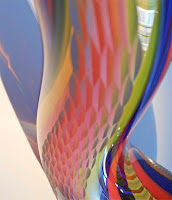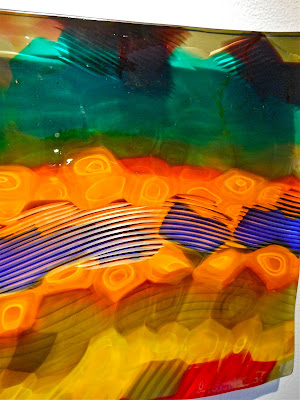 |
| Lino Tagliapietra, Venice, detail. |
Tagliapietra grew up on the glass-maker's island of Murano, in Venice. He became a glass apprentice at age eleven and a maestro by twenty-one. His mastery of historical techniques of Venetian glassblowing is important not only for his own exquisite and innovative oeuvre, but because he has shared his knowledge so far and wide. Through his innumerable collaborations and teaching, he is almost literally responsible for the burgeoning of art glass worldwide in the late twentieth century.
 |
| Lino Tagliapietra, Poesia, detail |
 |
| Fuji, blown glass, 19 1/4" h x 18 3/4" w x 11 1/2" d |
 |
| Lino Tagliapietro, Bahia, blown glass 26"h x 10" w x 6-3/4" d |
Tagliapietra uses glass blowing as if he were a scientist exploring the natures of mass and motion, density and lift. If we compare Fuji with Bahia, the one is like a seaweed balloon and the other like a dense, mythic gem, excised from obdurate stone. We can imagine back to the molten state of each form; we see that each has undergone considerable surface carving ("cold work"), but they tell different stories and put us in different moods.
 |
| Venice (22 1/4" h x 11 3/4 w x 3/4" d) foreground, and Fenice (13" h x 47" w x 4 3/4" d) background |
Setting aside the plaques, Tagliapietra's works either have as little contact with the ground as possible; or they are filled with lines and patterns so dynamic that they make us chase storms of motion within the glass-cased universe of the artwork. Even the most stable open forms, like cylinders, dance with motion. In the Osaka vase, huge "gestures" run up and around the vessel as if they were painted in momentary bursts of energy. It's as if the size and shape—the mass—is meant to anchor forceful currents that blow through the piece.
 |
| Osaka, blown glass, 22 1/2" h x 11 3/4" w |
 In several works, Tagliapietra energizes forms with this theatrical, linear gesture. In Poesia, the base of which I've pictured above, he shoots lines of white, brown, and caramel through clear glass. Of course we know that they are suspended—glass in glass—but it is difficult not to see them anyway as lines in motion, or as the contrails of magnificently agile flight. Poesia, too, is a cylinder, but one experiences the movement itself, not the object, which contains and displays the movement, allowing us to see what would otherwise remain invisible.
In several works, Tagliapietra energizes forms with this theatrical, linear gesture. In Poesia, the base of which I've pictured above, he shoots lines of white, brown, and caramel through clear glass. Of course we know that they are suspended—glass in glass—but it is difficult not to see them anyway as lines in motion, or as the contrails of magnificently agile flight. Poesia, too, is a cylinder, but one experiences the movement itself, not the object, which contains and displays the movement, allowing us to see what would otherwise remain invisible.  |
| Poesia, detail, looking through the vessel |
 |
| Fuji, detail |
 |
| Lino Tagliapietra, Venice, blown glass. Approx. 11" h x 26" w. |
 |
| Endeavor, detail |
 |
| Fenice, detail |
 |
| Bahia, detail |
The Rainbow Island is an incomparable show. Each of Tagliapietra's works is a triumph of industry, art, imagination, and love. To see these is to breathe the freshest air under the bluest sky, and he made them for our eyes. Dreams come true.
All photographs in this post were taken by the author.

No comments:
Post a Comment